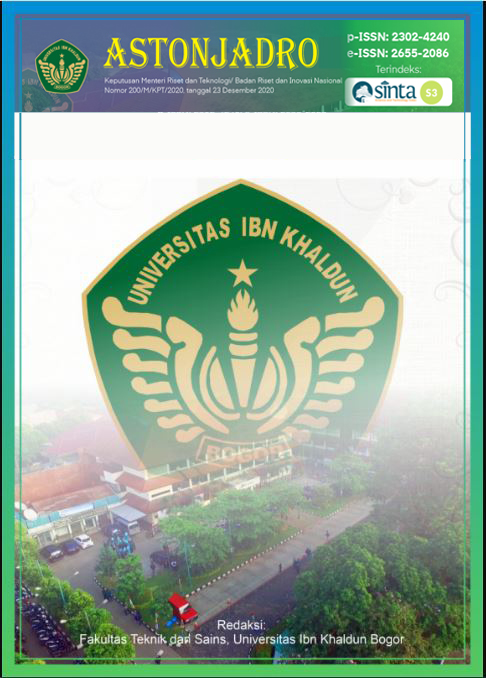Analysis of Clean Water Needs, Quality and Availability Projections in 2032 (Case Study: SMK Negeri 2 Manokwari)
DOI:
https://doi.org/10.32832/astonjadro.v12i1.8136Keywords:
clean water, water demand, water quality, SMK Negeri 2 Manokwari.Abstract
SMK Negeri 2 Manokwari West Papua Province is one of the vocational high schools that foster 12 competencies in the field of Technology and Engineering with 1,567 people active in 2022. To support daily activities at school, the availability of clean water in the school environment is necessary for washing hands, defecating, and urinating. The availability of clean water is at least balanced with the need for clean water, this is intended to ensure that school needs are fulfilled. This study aims to analyze the need for clean water and clean water quality by quality standards. Clean water needs are analyzed using a mathematical approach based on clean water planning criteria, while the clean water quality analysis is carried out by testing clean water samples through the Manokwari City BPOM laboratory. The results showed that the need for clean water in schools was 17,280 liters/day. Water distribution to bathrooms/toilets, sinks, and public face, uses a piping network sourced from 2 reservoirs with a capacity of 40,400 liters. The source of raw water used is groundwater and pumping systems. For the analysis of clean water quality, the data shows that the temperature parameter = 0.05 oC, pH = 7.88, TDS = 0.3060 mg/L, and coliform number = 27.09 x 10^1 CFU/100 mL, so that the water quality microbiologically does not meet the requirements for sanitary hygiene. While the results of the study showed that the need for clean water in SMK Negeri 2 Manokwari until 2032 reached 33,276 L/day (47.21%). The results of this study are expected to be useful for the development of science for academics in universities, government and society. E, especially for students at SMK Negeri 2 Manokwari, hopefully, it will be interesting reading material in the school library.
References
Antariza, Rispiningtati, A. (2011). Simulasi dan Optimasi Harga Air Bersih pada Proyek Waduk Titab Kabupaten Buleleng Propinsi Bali. Jurnal Teknik Pengairan, 2(2).
Artayana, B., & Indra, G. (2010). Perencanaan Instalasi Air Bersih dan Air Kotor Pada Bangunan Gedung dengan Menggunakan Sistem Pompa. Jurnal Ilmiah Teknik Mesin, 4(1), 51–56.
Noviyanti, S. (2014). Penyediaan Air Bersih Pada Kawasan Rawan Air Bersih di Pesisir Utara Lamongan. Tataloka, 16(2), 116–130.
Priyono, Yuliani, S. (2013). Studi Penentuan Status Mutu Air di Sungai Surabaya untuk Keperluan Bahan Baku Air Minum. Jurnal Teknik Pengairan, 4(1), 53–60.
Wahyu Diana, E., Sholichin, M., & Haribowo, R. (2020). Kajian Pengembangan Jaringan Distribusi Air Bersih pada PDAM Tirta Barito Kota Buntok. Jurnal Teknik Pengairan, 11(1), 8–17. https://doi.org/10.21776/ub.pengairan.2020.011.01.02.
B Ginanjar, F Hariati. 2015. ANALISIS KOEFISIEN DEBIT MODEL ALAT UKUR CELAH SEGIEMPAT DI LABORATORIUM HIDROLIKA TEKNIK SIPIL UNIVERSITAS IBN KHALDUN BOGOR. ASTONJADRO 4 (2), 18-24.
MP Alam, M Lutfi, 2016. ANALISIS TREND HIDROGRAF TERHADAP SIMULATOR HUJAN SATU MODEL DAS DENGAN METODE HSS GAMA I. ASTONJADRO 5 (2), 58-66.
MZ Suhadi, I Namara. 2016. PERENCANAAN TEKNIS PEMBANGUNAN PRASARANA SANITASI (STUDI KASUS PEMBANGUNAN PRASARANA SANITASI DI KAMPUNG CIKUKUL DESA NAGRAK SELATAN KABUPATEN SUKABUMI). ASTONJADRO 5 (2), 35-45.
M Imamuddin, D Cahyanto. 2020. ANALYSIS OF DRAINAGE CHANNEL CAPACITY AT SINDANG STREET IN SINDANG HOUSE PUMP AREA. ASTONJADRO 9 (2), 132-144.
B Barid, BO Afanda. 2022. Increasing peak flow of snyder synthetic hydrograph units in the serenan sub-watershed of Bengawan Solo Watershed. ASTONJADRO 11 (3), 616-626.
ADR Atthar, MM Sari, IWK Suryawan. 2022. Alternative medical waste treatment during COVID-19 case study in Hospital X Jakarta City. ASTONJADRO 11 (3), 569-575
M Lutfi, N Chayati, R Rulhendri, D Azhari. 2022. Assessment of building seismic risk in the environment of Ibn Khaldun University Bogor. ASTONJADRO 11 (3), 517-525.
A Amrullah, E Erniati, M Chaerul. 2021. BUILDING PROTECTION DESIGN IN FIRE HAZARD PREVENTION (Case Study: Fajar University Building (UNIFA) Makassar). ASTONJADRO 11 (1), 50-60.
I Prastowo. 2020. REVIEW OF BUILDING MAINTENANCE AND MAINTENANCE MANAGEMENT SYSTEM AT THE SUNAN HOTEL SOLO. ASTONJADRO 9 (2), 145-158.
S Yarsono, M Imamuddin, J Suwandi, LM TN, I Wulandari, B Al Hanif, 2020. PENGARUH PERUBAHAN DIMENSI TANGKI TERHADAP DESAIN PONDASI EKSISTING TANGKI REAKTOR PILOT PLANT BIOGAS POME. ASTONJADRO 9 (1), 24-29.
Downloads
Published
How to Cite
Issue
Section
License
Copyright (c) 2022 ASTONJADRO

This work is licensed under a Creative Commons Attribution-ShareAlike 4.0 International License.
Paper submitted to ASTONJADRO is the sole property of the Astonjadro Journal. Unless the author withdraws the paper because he does not want to be published in this journal. The publication rights are in the journal Astonjadro.ASTONJADRO
LICENSE
This work is licensed under a Creative Commons Attribution-ShareAlike 4.0 International License.
Based on a work at http://ejournal.uika-bogor.ac.id/index.php/ASTONJADRO













